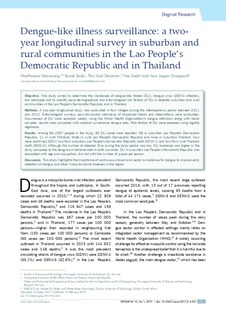| dc.contributor.author | Vannavong, Nanthasane | |
| dc.contributor.author | Seidu, Razak | |
| dc.contributor.author | Stenstrom, Thor Axel | |
| dc.contributor.author | Dada, Nsa | |
| dc.contributor.author | Overgaard, Hans Jørgen | |
| dc.date.accessioned | 2020-01-20T07:58:34Z | |
| dc.date.available | 2020-01-20T07:58:34Z | |
| dc.date.created | 2019-12-13T12:02:06Z | |
| dc.date.issued | 2019 | |
| dc.identifier.citation | Western Pacific Surveillance and Response Journal. 2019, 10 (1) | nb_NO |
| dc.identifier.issn | 2094-7321 | |
| dc.identifier.uri | http://hdl.handle.net/11250/2636904 | |
| dc.description.abstract | Objective: This study aimed to determine the incidences of dengue-like illness (DLI), dengue virus (DENV) infection, and serotypes and to identify socio-demographical and entomological risk factors of DLI in selected suburban and rural communities in the Lao People’s Democratic Republic and in Thailand.
Methods: A two-year longitudinal study was conducted in four villages during the inter-epidemic period between 2011 and 2013. Entomological surveys, semi-structured interviews of household heads and observations were conducted. Occurrences of DLI were recorded weekly using the World Health Organization’s dengue definition along with blood samples; results were compared with national surveillance dengue data. Risk factors of DLI were assessed using logistic regression.
Results: Among the 2007 people in the study, 83 DLI cases were reported: 69 in suburban Lao People’s Democratic Republic, 11 in rural Thailand, three in rural Lao People’s Democratic Republic and none in suburban Thailand. Four were confirmed DENV: two from suburban Lao People’s Democratic Republic (both DENV-1) and two from rural Thailand (both DENV-2). Although the number of detected DLIs during the study period was low, DLI incidence was higher in the study compared to the dengue surveillance data in both countries. DLI in suburban Lao People’s Democratic Republic was associated with age and occupation, but not with the number of pupae per person.
Discussion: This study highlights the importance of continuous clinical and vector surveillance for dengue to improve early detection of dengue and other mosquito-borne diseases in the region. | nb_NO |
| dc.language.iso | eng | nb_NO |
| dc.publisher | World Health Organization | nb_NO |
| dc.rights | Navngivelse 4.0 Internasjonal | * |
| dc.rights.uri | http://creativecommons.org/licenses/by/4.0/deed.no | * |
| dc.title | Dengue-like illness surveillance: a two-year longitudinal survey in suburban and rural communities in the Lao People’s Democratic Republic and in Thailand. | nb_NO |
| dc.type | Journal article | nb_NO |
| dc.description.version | publishedVersion | nb_NO |
| dc.source.volume | 10 | nb_NO |
| dc.source.journal | Western Pacific Surveillance and Response Journal | nb_NO |
| dc.source.issue | 1 | nb_NO |
| dc.identifier.doi | 10.5365/wpsar.2017.8.4.001 | |
| dc.identifier.cristin | 1760492 | |
| dc.relation.project | Norges forskningsråd: 191652 | nb_NO |
| dc.description.localcode | Creative Commons Attribution 3.0 IGO license (CC BY 3.0 IGO http://creativecommons.org/licenses/by/3.0/igo/legalcode), which permits unrestricted use, distribution and reproduction in any medium, provided the original work is properly cited. In any use of these articles, there should be no suggestion that WHO endorses any specific organization, products or services. | nb_NO |
| cristin.unitcode | 194,64,93,0 | |
| cristin.unitname | Institutt for havromsoperasjoner og byggteknikk | |
| cristin.ispublished | true | |
| cristin.fulltext | original | |

